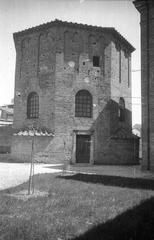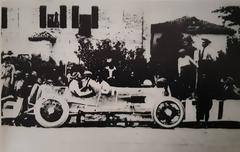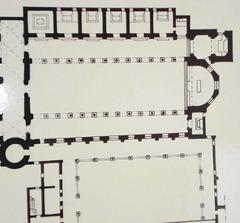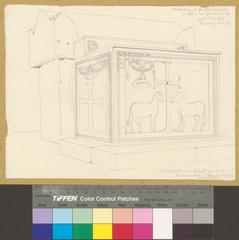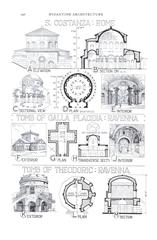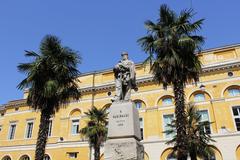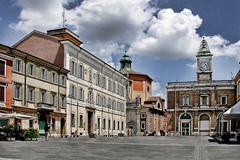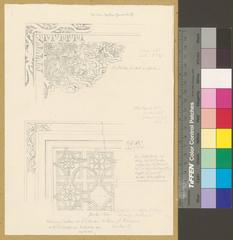Civitas Classis Ravenna: Visiting Hours, Tickets, and Historical Sites Guide
Date: 15/06/2025
Introduction: Civitas Classis Ravenna—History and Significance
Just outside the historic city of Ravenna, Italy, the site of Civitas Classis—better known as Classe—stands as a unique testament to over two millennia of Mediterranean history. From its beginnings as a Roman naval base founded around 27 BCE by Emperor Augustus, Classe developed from Etruscan-Umbrian roots into one of the most significant ports of the Roman Empire. The site’s strategic importance was underscored by its capacity to host a major fleet, making it a key military and commercial hub (Wikipedia).
As Ravenna became the capital of the Western Roman Empire in 402 CE, Classe flourished, evolving into a center of both religious and artistic achievement. Its crowning architectural treasure, the Basilica of Sant’Apollinare in Classe—consecrated in 549 CE and now a UNESCO World Heritage Site—exemplifies the city’s Byzantine legacy through its celebrated mosaics (Full Suitcase). Today, visitors can explore an archaeological park that encompasses the basilica, the innovative Classis Ravenna Museum (in a restored sugar factory), and the remains of the ancient port. This guide provides everything you need to plan your visit, including updated information on visiting hours, ticketing, accessibility, tours, and practical tips, making Classe an essential destination for history enthusiasts, cultural travelers, and families alike (Classis Ravenna Museum, Visit Italy).
Guide Overview
- Historical context and evolution of Classe
- Practical visitor information: hours, tickets, accessibility, tours
- Highlights of main attractions: Basilica di Sant’Apollinare in Classe, Classis Ravenna Museum, Ancient Port of Classe
- Tips for families, photographers, and cultural travelers
- Answers to frequently asked questions
- Suggestions for further exploration and engagement
Historical Context: Classe and Ravenna
Early Origins
Archaeological evidence reveals that Classe’s story begins as early as 1400 BCE with settlements by Etruscan-Umbrian and Gallic peoples. The marshy terrain, interlaced with rivers and lagoons, provided both resources and natural defenses, and laid the foundation for its later development. By the 2nd century BCE, the Via Popilia connected Ravenna to other important Roman cities, setting the stage for future growth.
Roman Naval Base and Urban Expansion
The transformation of Classe began in earnest in 27 BCE when Augustus established Portus Classis, the main base for Rome’s Adriatic fleet. By the 1st century CE, the town had grown into a bustling urban center, home to a diverse mix of naval personnel, merchants, and their families. The port could host up to 250 ships, making it one of the empire’s largest and most vital naval stations (Wikipedia).
Imperial Capital and Religious Center
When Ravenna became the imperial capital in 402 CE, Classe’s fortunes rose further. The construction of monumental religious buildings, including the Basilica of Sant’Apollinare in Classe, cemented its status as both a logistical and spiritual hub. The basilica’s mosaics, dating from the sixth century, are celebrated for their vivid colors and intricate iconography, reflecting the city’s role in the spread of Christianity (Full Suitcase).
Decline and Rediscovery
Classe’s decline began in the wake of the Lombard invasions of the late sixth century, exacerbated by environmental changes that led to the silting-up of its harbor. By the eighth century, the area was largely abandoned as a port, though its religious and cultural legacy endured. Modern archaeological efforts have brought to light streets, buildings, and artifacts that narrate the site’s complex history (Ancient Origins, Corvinus).
Practical Visitor Information
Visiting Hours
-
Classis Ravenna Museum
- Tuesday to Sunday: 9:00 AM – 7:00 PM
- Closed Mondays (except holidays)
- Last admission: 1 hour before closing
-
Basilica di Sant’Apollinare in Classe
- Daily: 9:00 AM – 7:00 PM
Always verify updated hours on official websites before your visit, as schedules may change seasonally or due to special events.
Tickets and Prices
-
Classis Ravenna Museum:
- Adults: €8
- Reduced (EU citizens 18–25): €5
- Under 18: Free
-
Basilica di Sant’Apollinare in Classe:
- Adults: €4
- Reduced: €2
- Under 18: Free
-
Combined tickets and guided tour options are available.
-
Tickets can be purchased online via the Ravenna Tourism website or at site entrances.
How to Get There
- By Car: About 10 minutes from Ravenna’s center; parking is available.
- By Public Transport: Regular bus service from central Ravenna; check local timetables.
- By Train: Classe is on the line connecting Ravenna with Bologna, Faenza, Ferrara, and Rimini.
- By Bicycle: A dedicated cycle path links Classe with Ravenna.
Accessibility
- Both museum and basilica are wheelchair accessible.
- Facilities for visually and hearing-impaired visitors are available upon request.
- Free parking and spaces for RVs and coaches are provided (Classis Ravenna).
Guided Tours and Special Events
- Guided tours in multiple languages are offered; advance booking is recommended.
- The site hosts cultural events, workshops, and exhibitions; check the Classis Ravenna calendar for details.
Photography
- The basilica’s mosaics and the archaeological park offer exceptional photo opportunities, especially during early morning or late afternoon.
- Photography is generally permitted but check for restrictions regarding flash or tripods.
Main Attractions: What to See in Classe
Basilica di Sant’Apollinare in Classe
- One of the world’s finest early Christian basilicas
- Features 24 marble columns and a stunning sixth-century apse mosaic
- Included in the UNESCO World Heritage list for its artistic and historical value
Classis Ravenna Museum
- Housed in a restored sugar factory, presenting over 600 artifacts
- Multimedia timeline and 3D reconstructions illuminate Classe’s evolution
- Exhibits span from prehistory to the Middle Ages, focusing on the Roman and Byzantine eras
Ancient Port of Classe
- Open-air site with remains of docks, warehouses, and the Via Caesaris
- Informative panels and reconstructions help visualize the ancient infrastructure
Other Notable Sites
- Foundations and mosaics of early Christian and Arian basilicas
- The Tyche of Ravenna (marble head displayed in the museum)
- Nearby natural attractions like the Pineta di Classe and Po Delta Park
Cultural Legacy and UNESCO Recognition
Classe’s archaeological and cultural treasures have earned it a prominent place within Ravenna’s World Heritage designation. The preservation of the site and its integration into the museum experience allow visitors to directly engage with the Roman, Ostrogothic, and Byzantine eras, deepening appreciation for Ravenna’s role as a cultural crossroads (PlanetWare).
Visitor Tips
- Recommended visit duration: 1.5–2 hours at the museum; allow extra time for the basilica and port.
- Optimal photo conditions: Visit in the morning or late afternoon for best natural light.
- Family-friendly: Interactive exhibits and open spaces make the site suitable for all ages.
- Dining: Several cafes and restaurants are located in nearby Ravenna.
Frequently Asked Questions (FAQ)
Q: What are the best times to visit to avoid crowds?
A: Weekdays in spring or autumn are typically quieter.
Q: Are guided tours available in English?
A: Yes, but advance booking is recommended.
Q: Are there combined tickets for museum and basilica?
A: Yes, combination tickets provide value and convenience.
Q: Is the site accessible for people with disabilities?
A: Yes, both museum and basilica are wheelchair accessible.
Q: Are there nearby attractions?
A: Yes, including Ravenna’s other UNESCO sites, Adriatic beaches, and local nature reserves.
Enhance Your Visit
- Download the Audiala app for interactive guides and real-time updates.
- Check the RavennAntica website and Classis Ravenna Museum site for official news, tickets, and events.
- Follow Ravenna’s tourism channels for the latest on exhibitions, concerts, and cultural programs.
Key Takeaways
Civitas Classis, situated near Ravenna, offers an unparalleled journey through the Mediterranean’s rich historical layers—from its role as a Roman naval stronghold to its place as a center of Christian and Byzantine art. The archaeological park, highlighted by the Basilica di Sant’Apollinare in Classe and the Classis Ravenna Museum, provides a comprehensive visitor experience supported by modern facilities and engaging interpretive tools. Whether you are a history buff, cultural traveler, or family, Classe promises a rewarding exploration of Ravenna’s past and present (PlanetWare, Wikipedia).
References
- Exploring Classe: Visiting Hours, Tickets, and the Rich History of Ravenna’s Historic Port, 2024 (Classis Ravenna Museum)
- Discover Civitas Classis: A Guide to Classe Visiting Hours, Tickets, and Ravenna Historical Sites, 2024 (Wikipedia)
- Archaeological Park of Classe Visiting Hours, Tickets, and Ravenna Historical Sites: A Complete Guide, 2024 (RavennAntica)
- Civitas Classis Ravenna Museum: Visiting Hours, Tickets & Historical Insights, 2024 (whichmuseum.co.uk)
- Basilica of Sant’Apollinare in Classe UNESCO Information, 2024 (Full Suitcase)
- Visit Italy Ravenna Classis Museum and Basilica Tickets, 2024 (Visit Italy)
- PlanetWare Ravenna Tourist Attractions, 2024 (PlanetWare)
For a deeper dive into Ravenna’s history, related sites, and cultural events, explore our recommended articles and download the Audiala app for enhanced audio guides and on-the-go visitor information.
